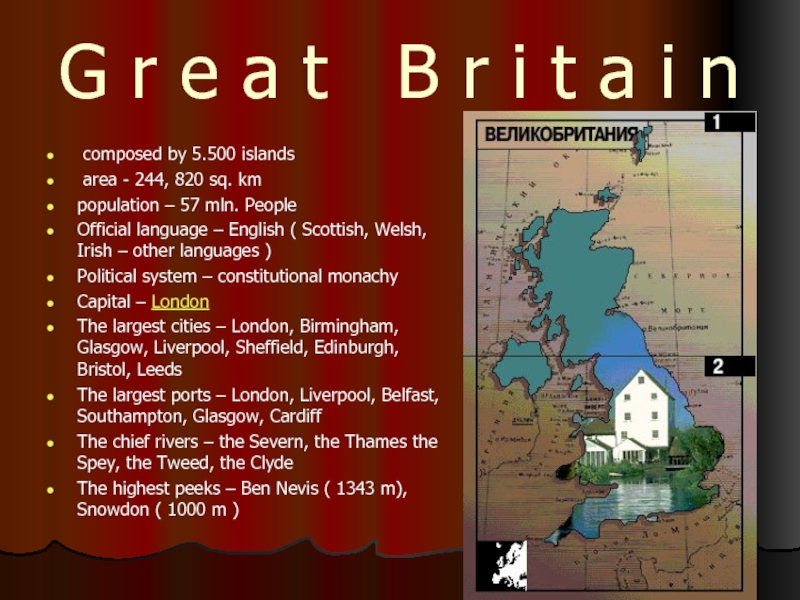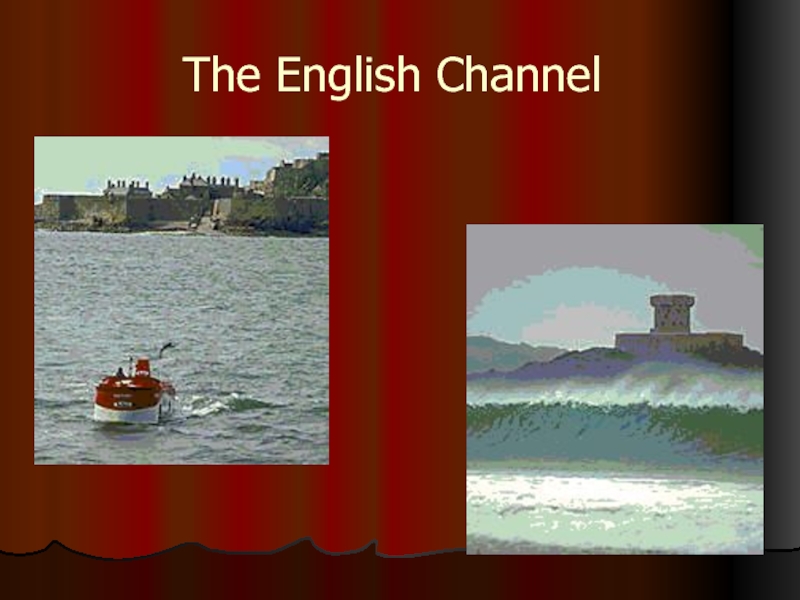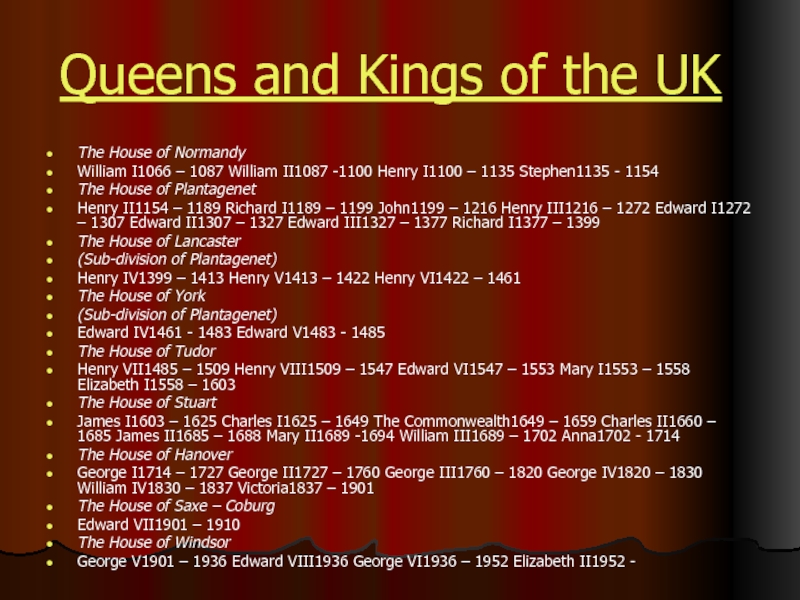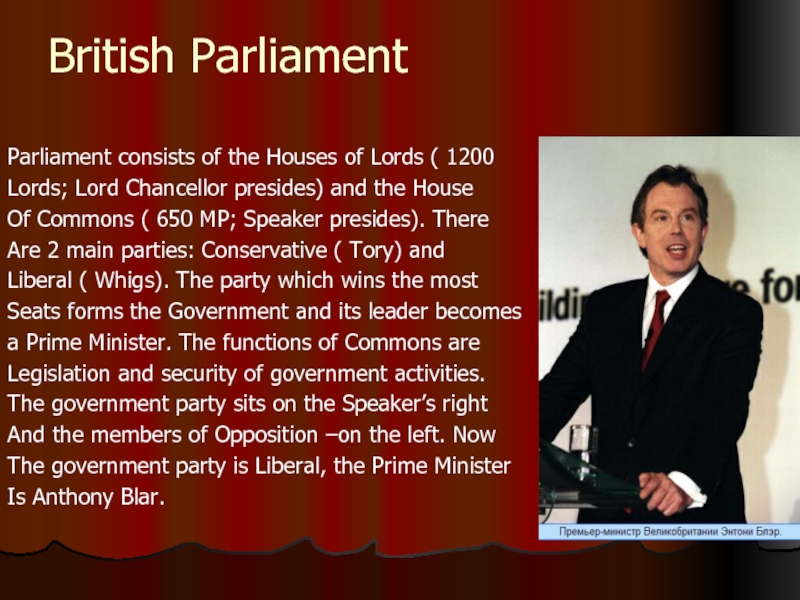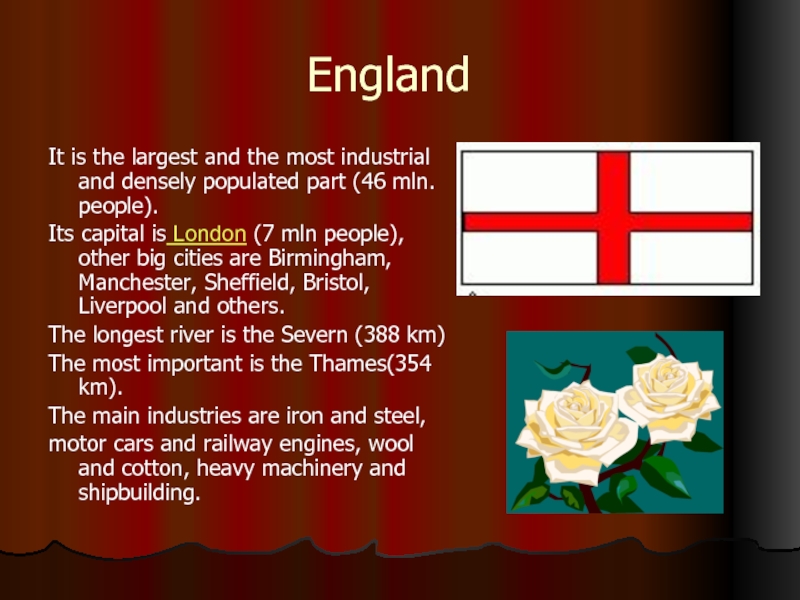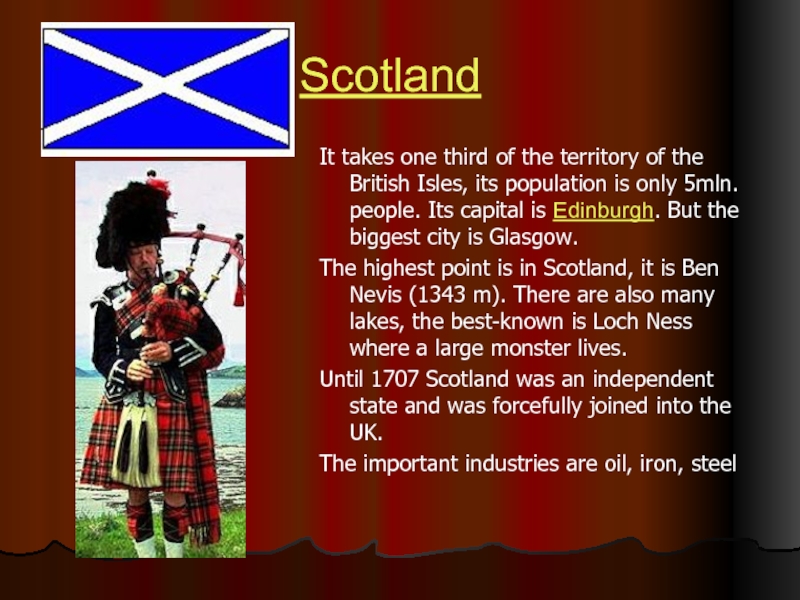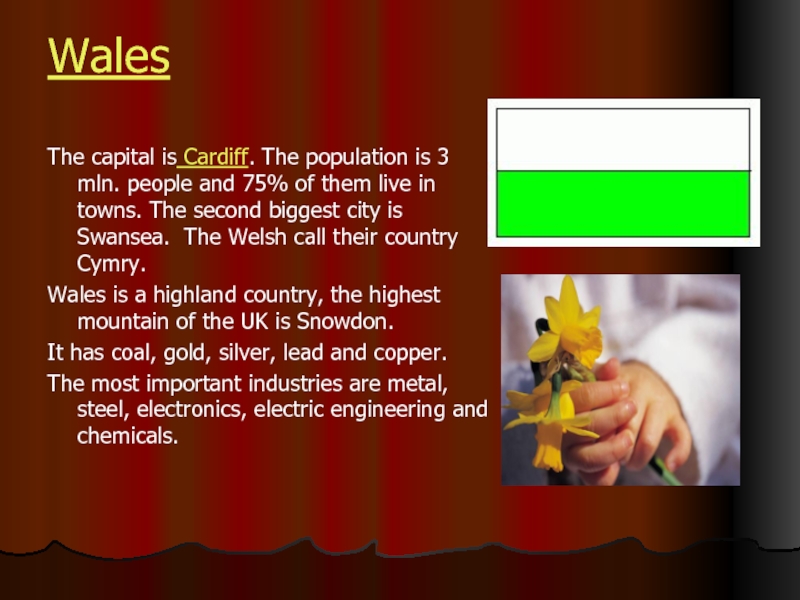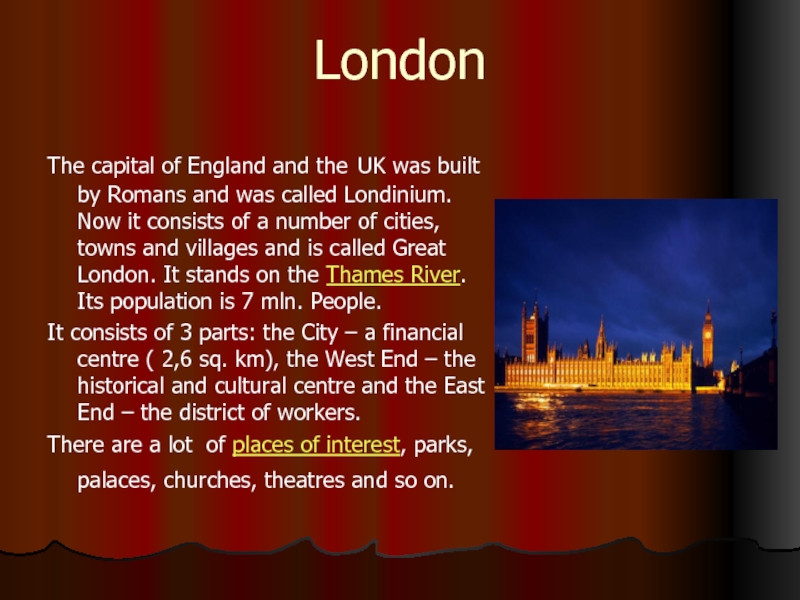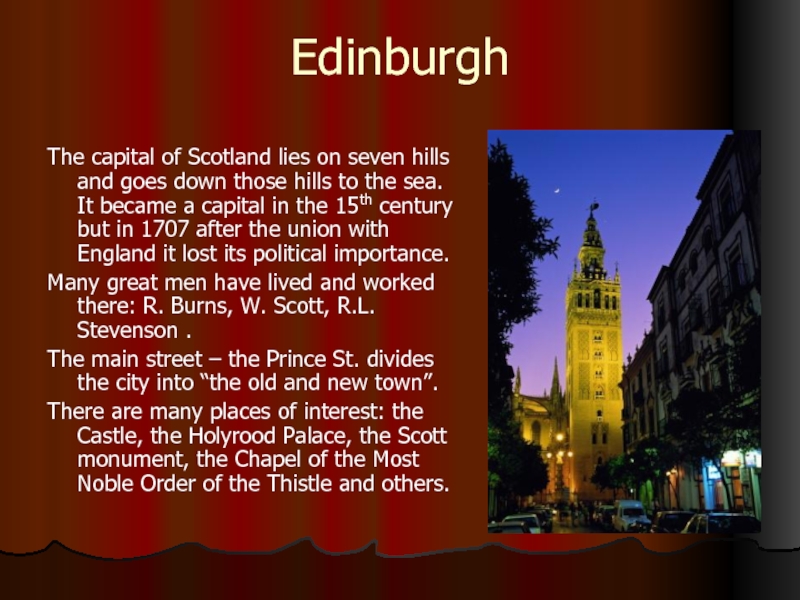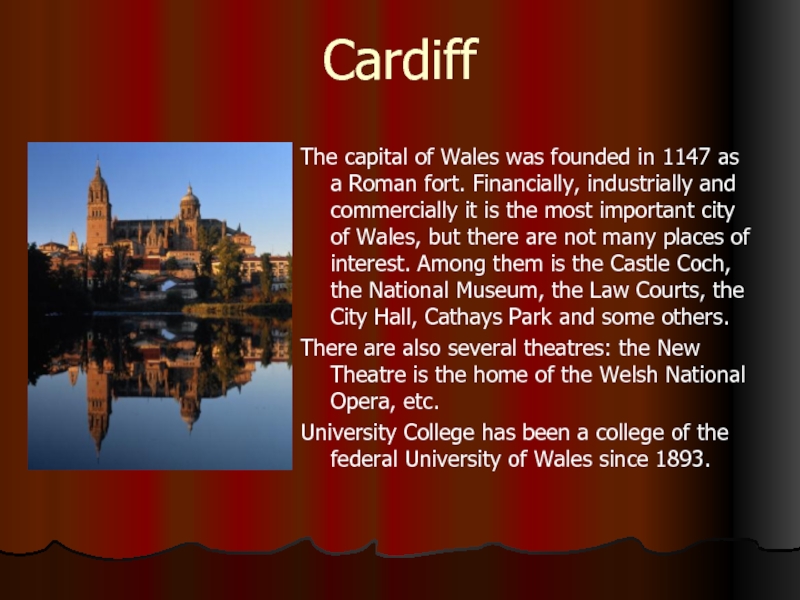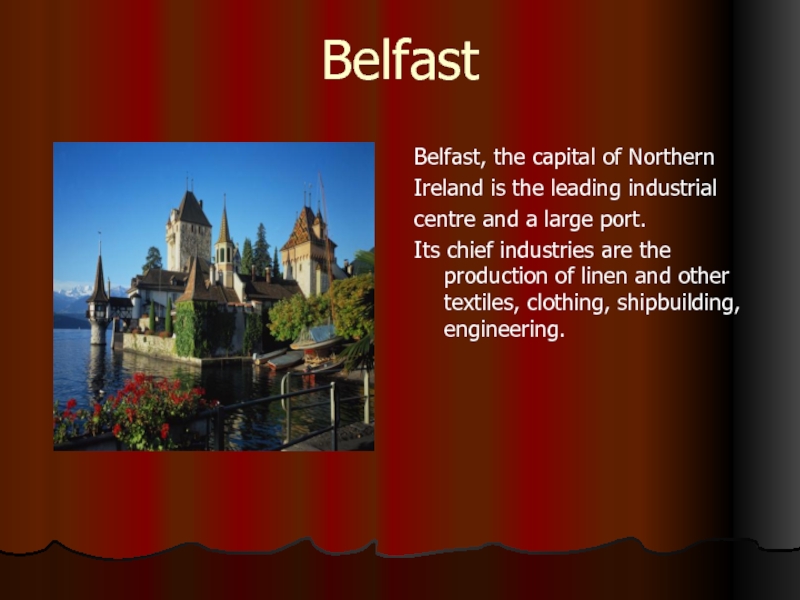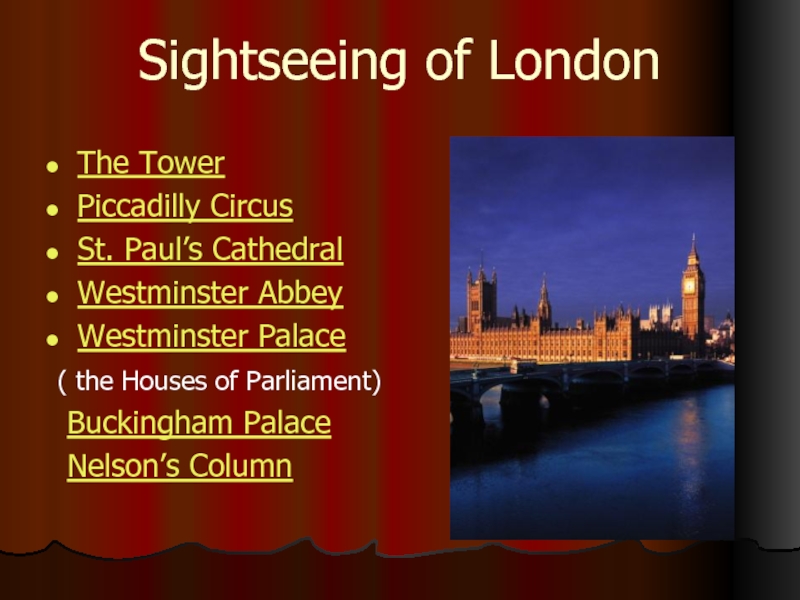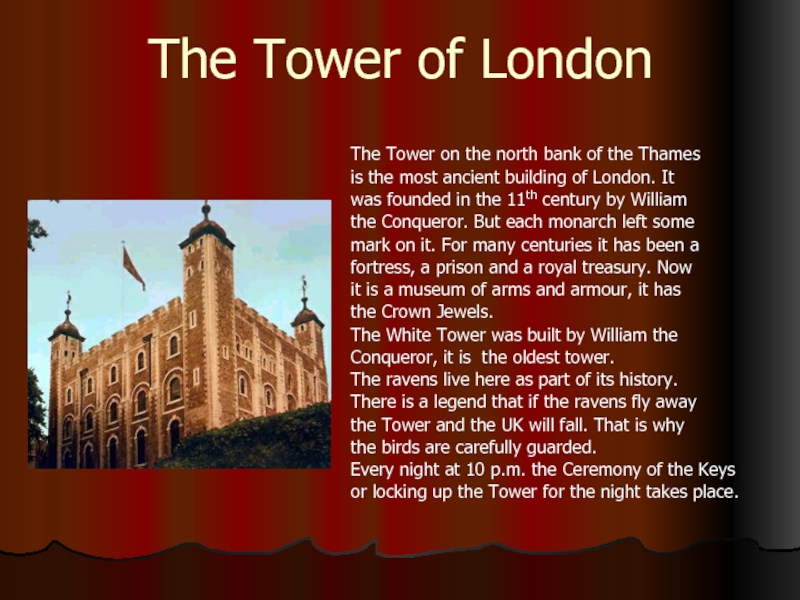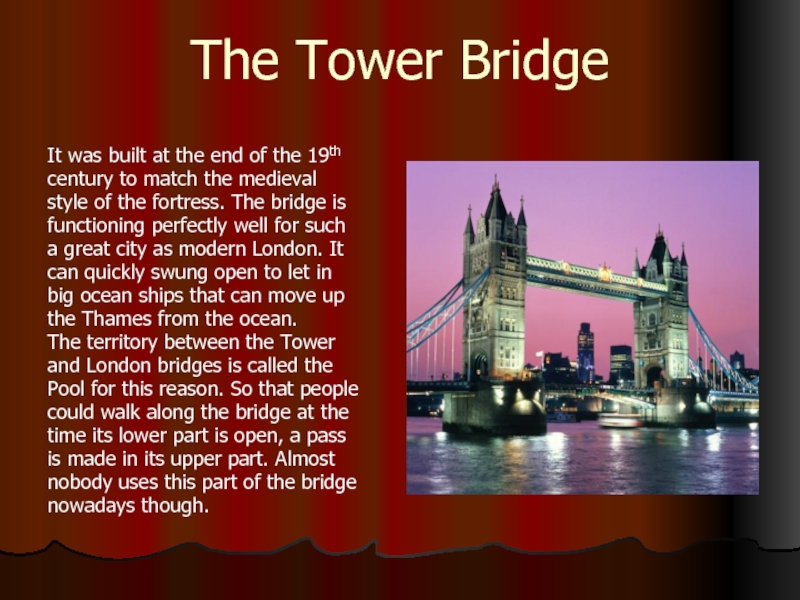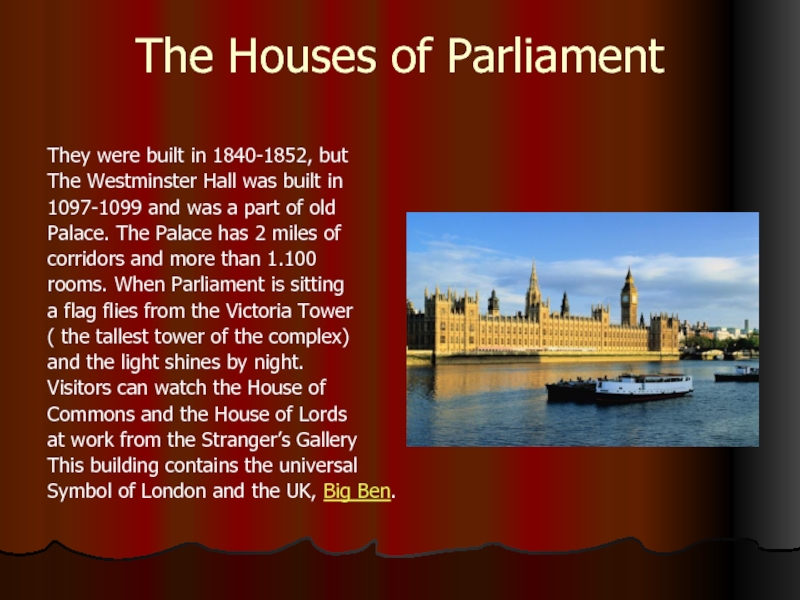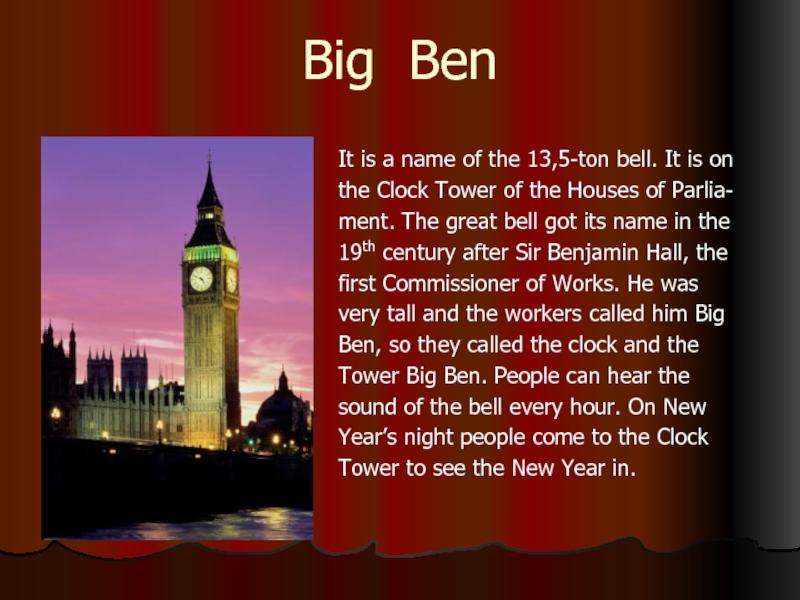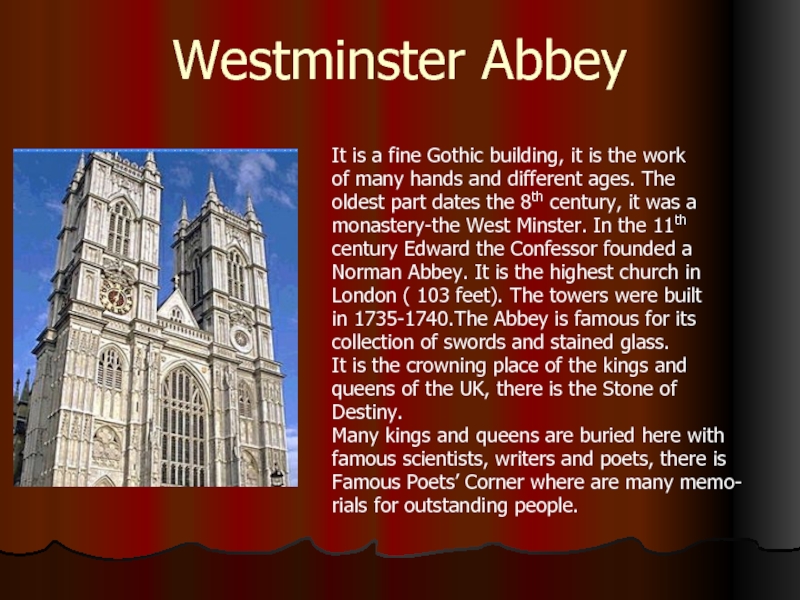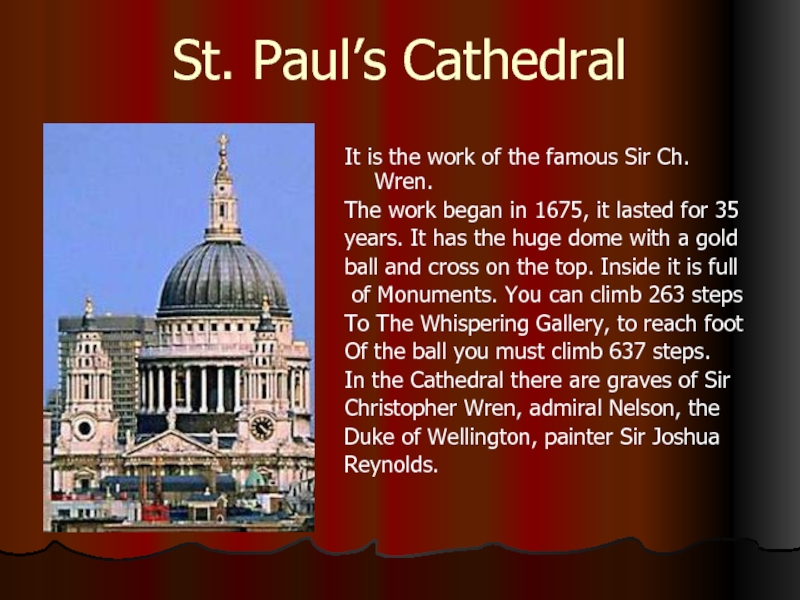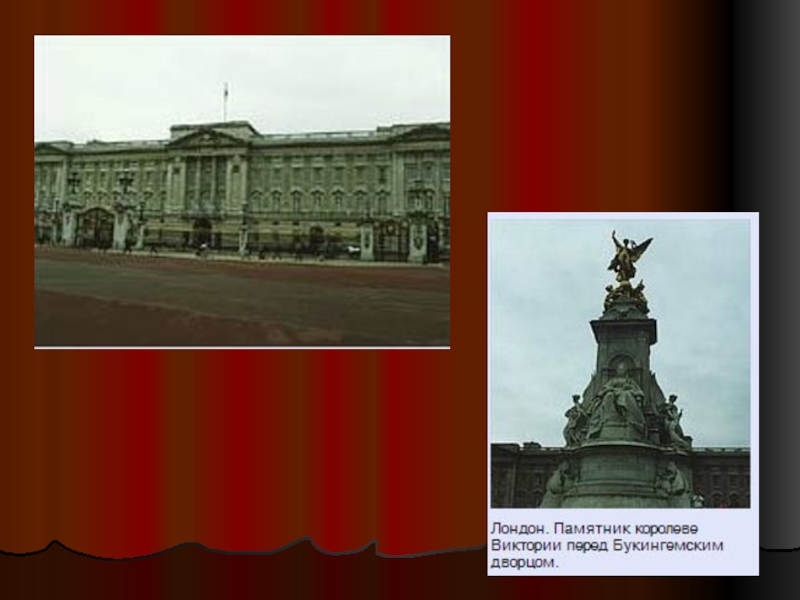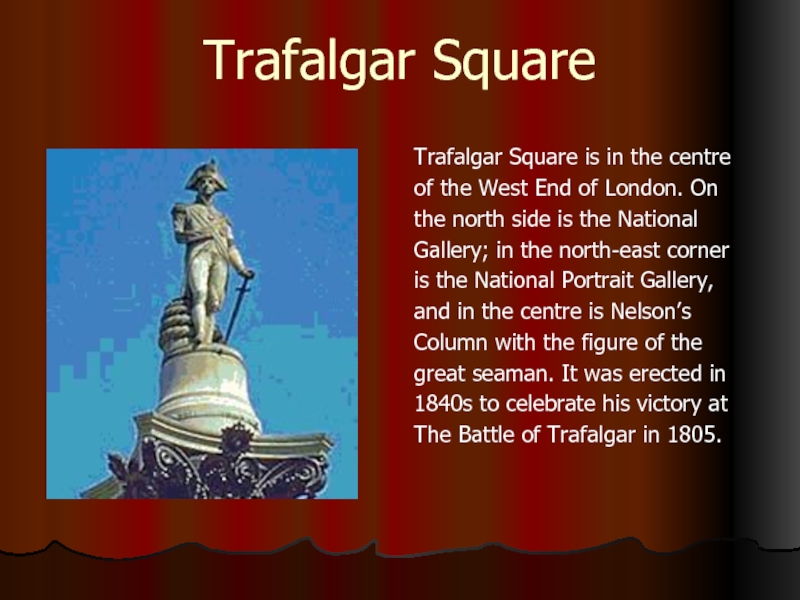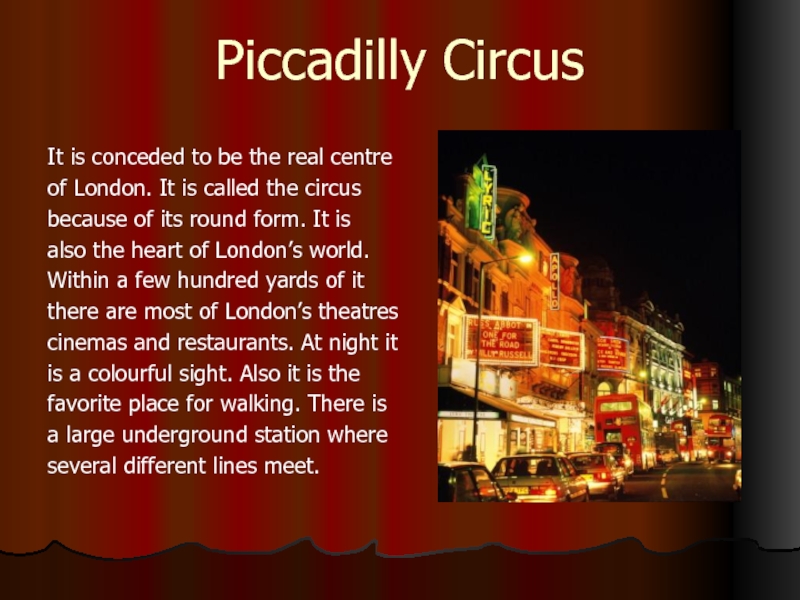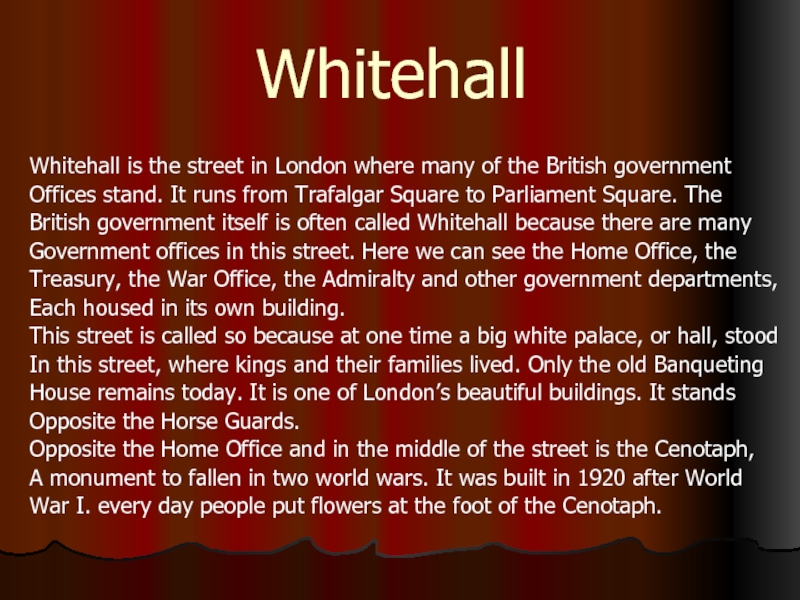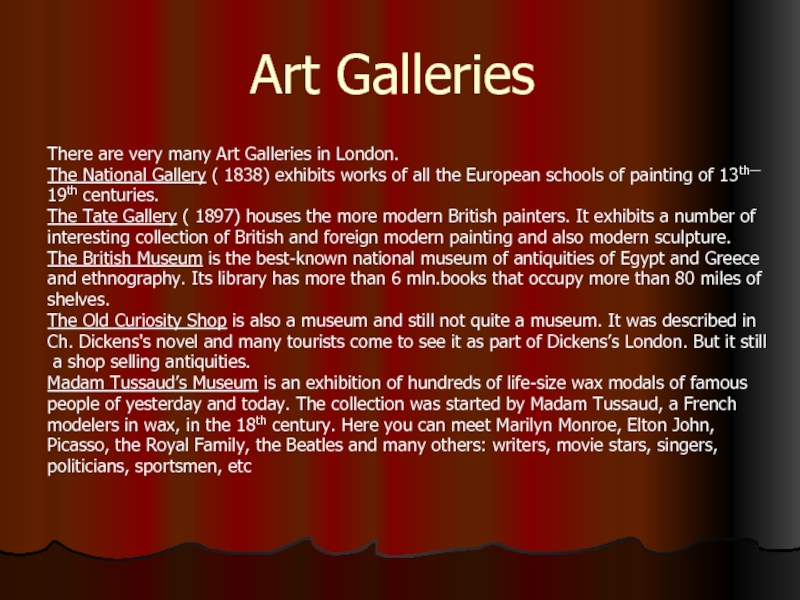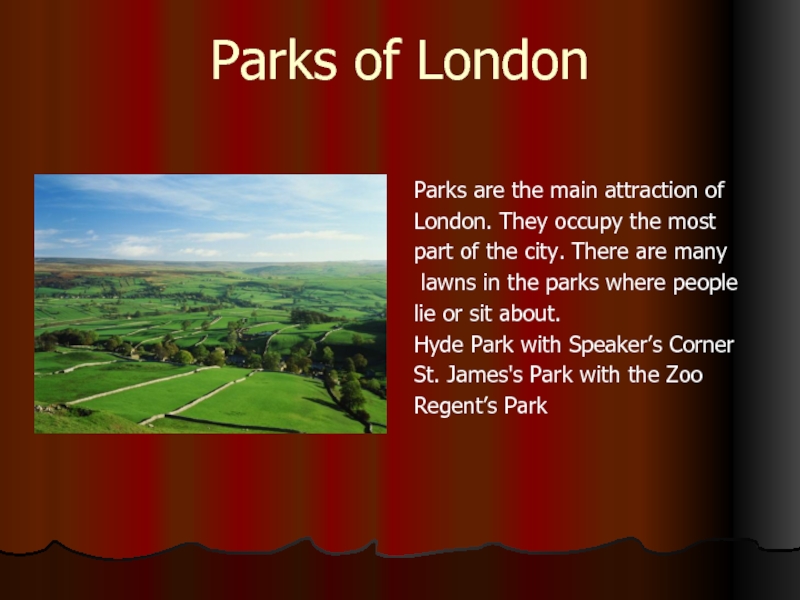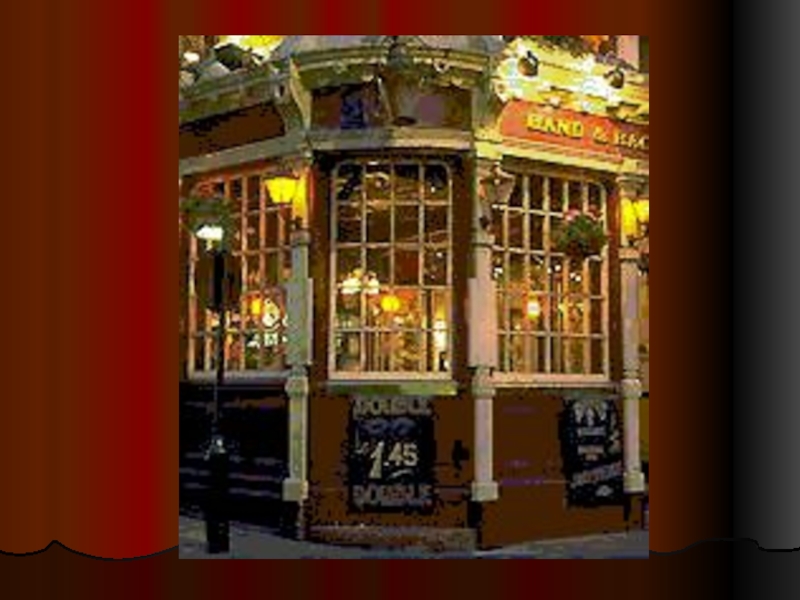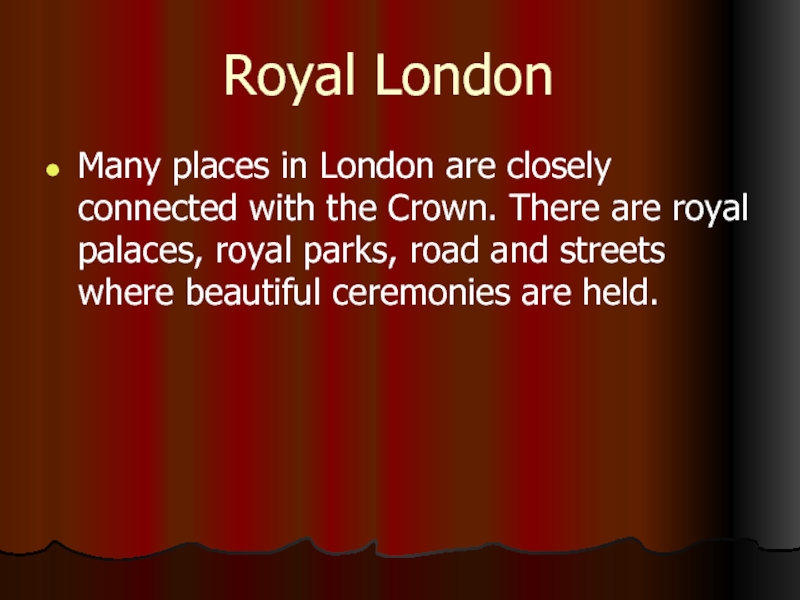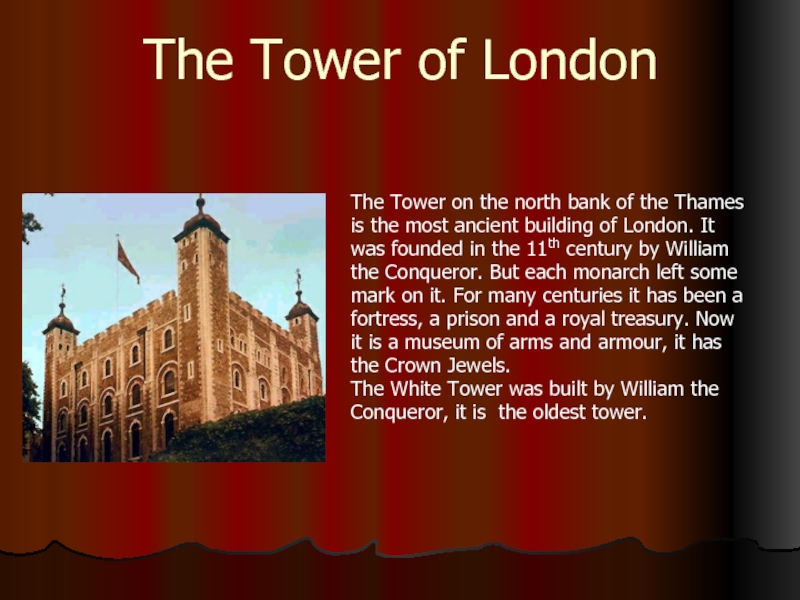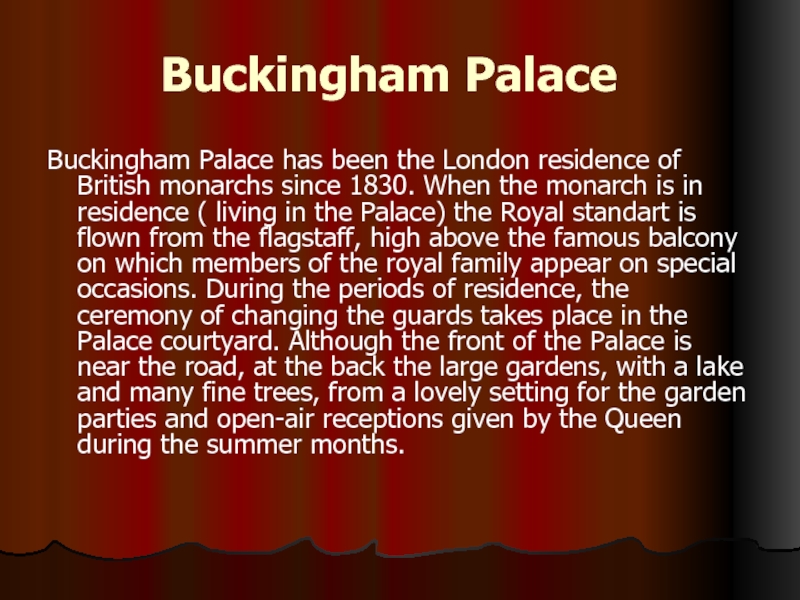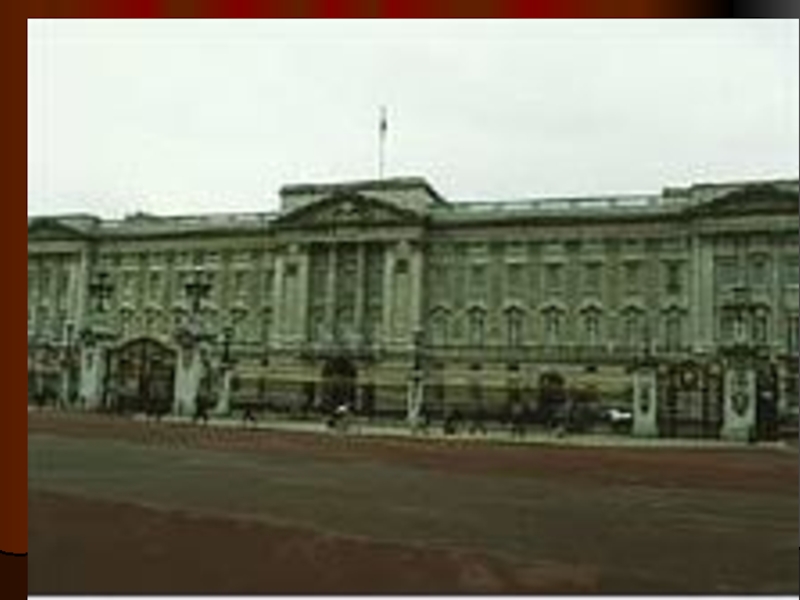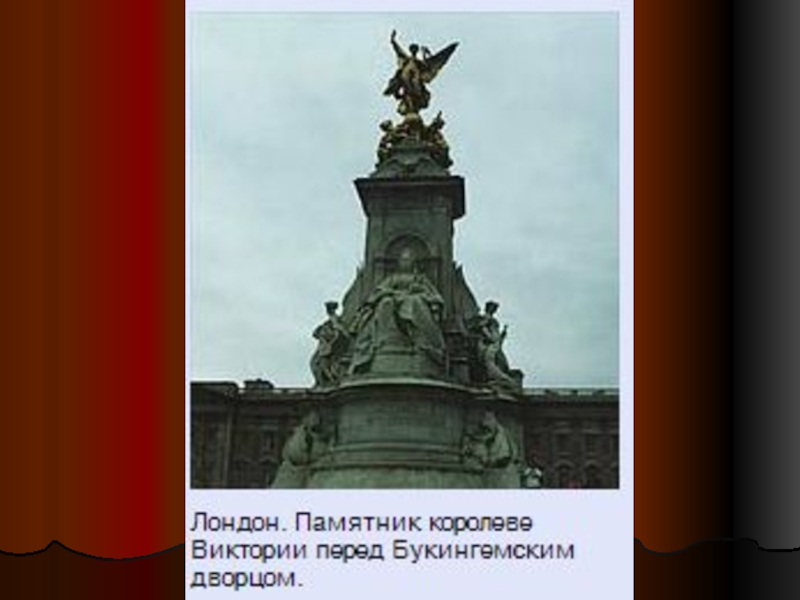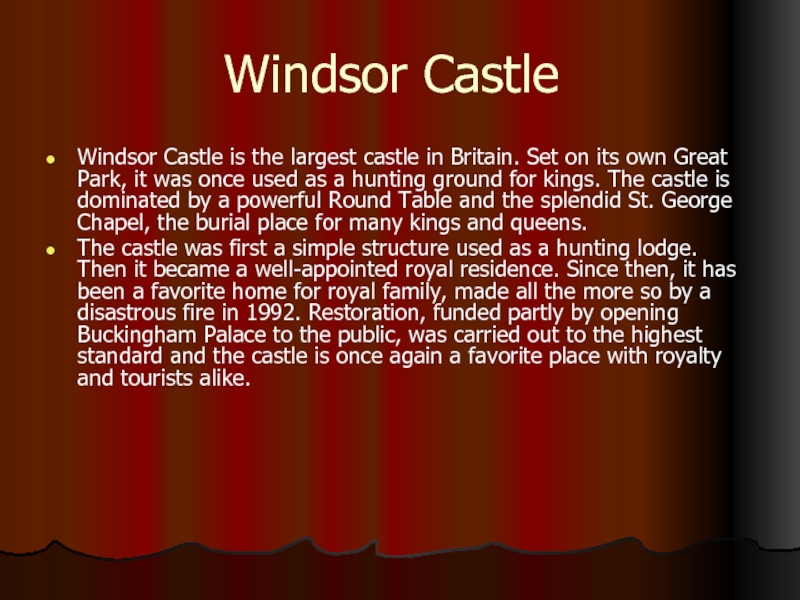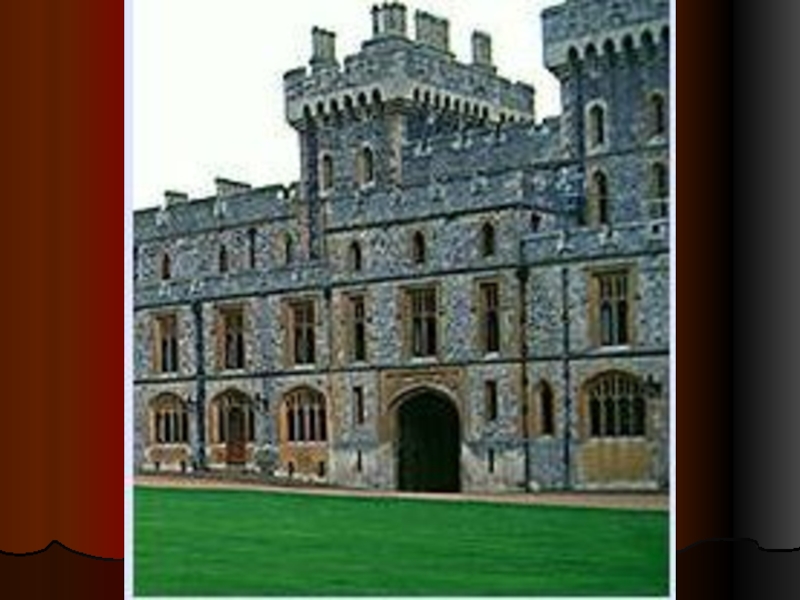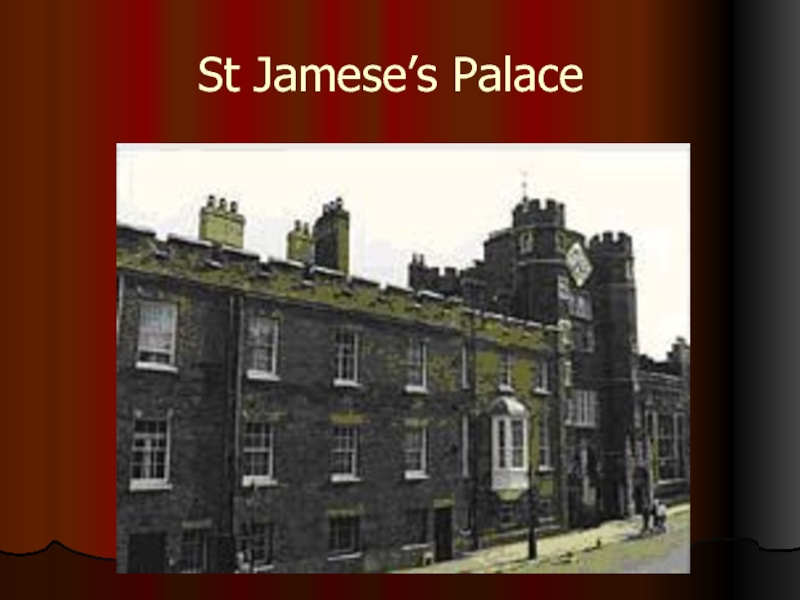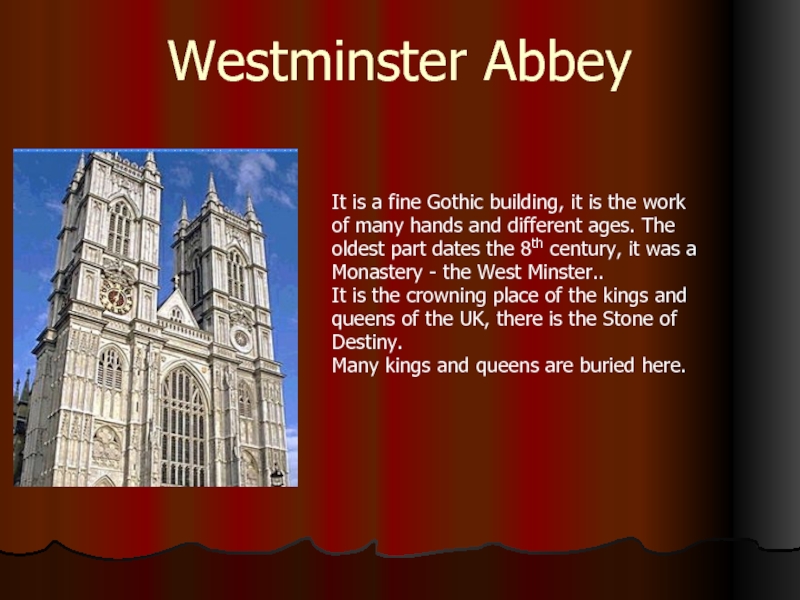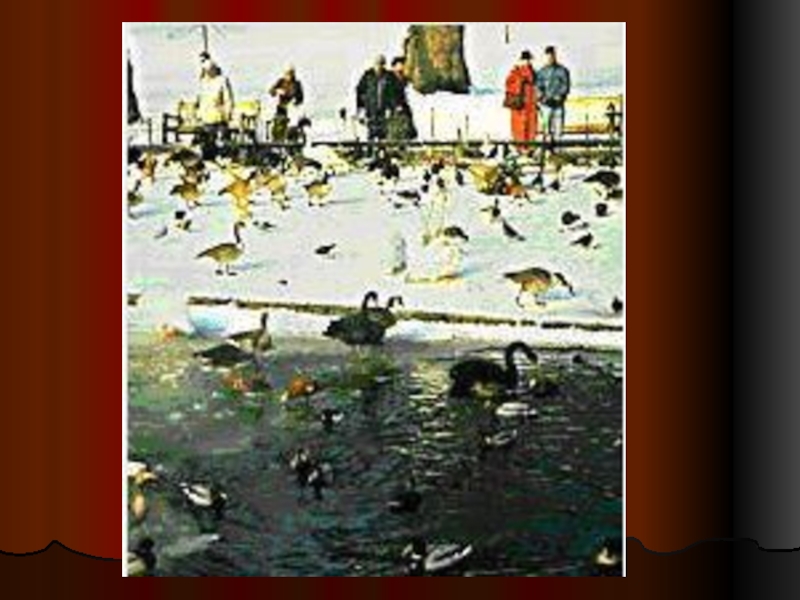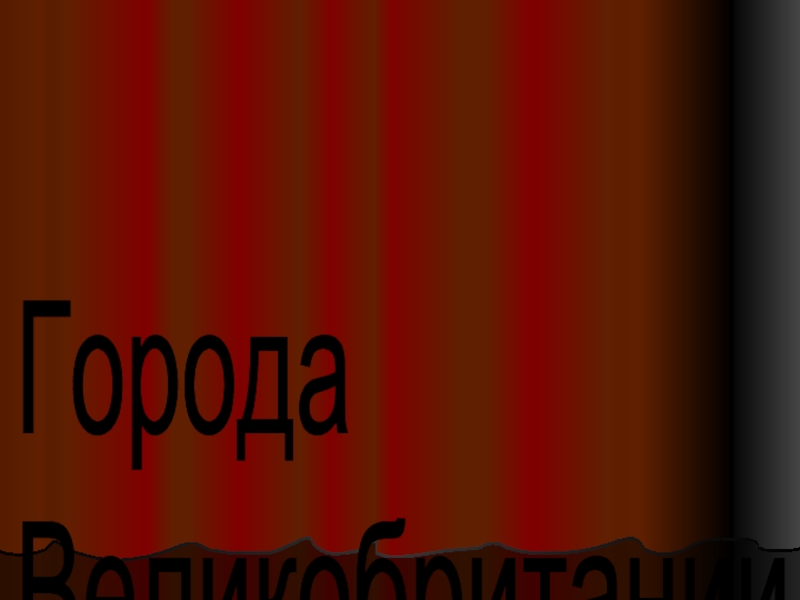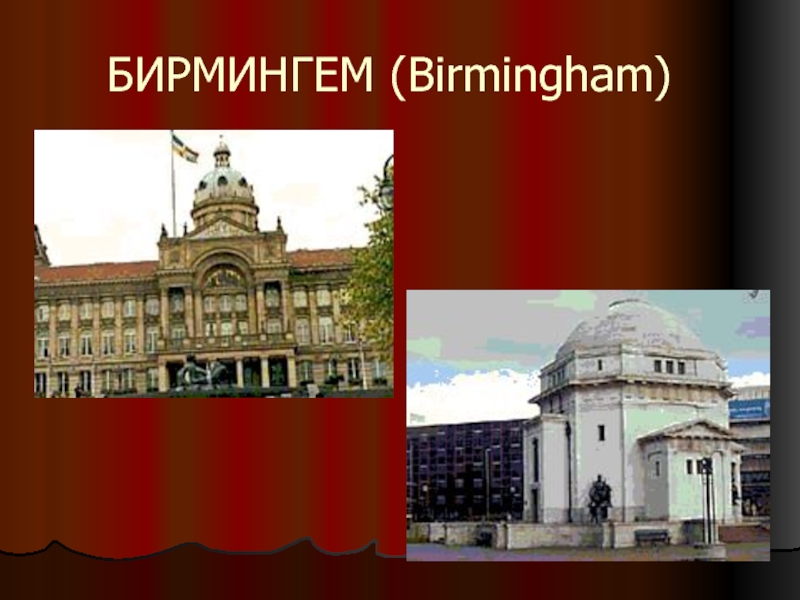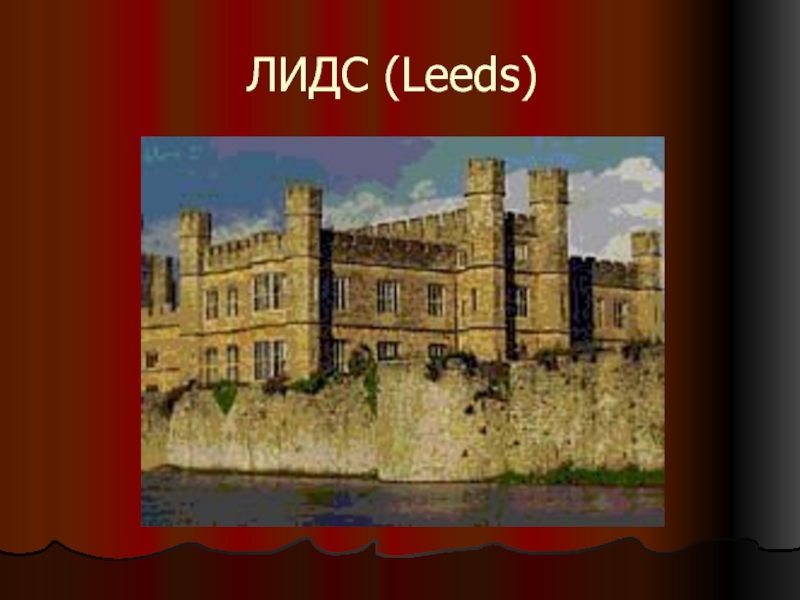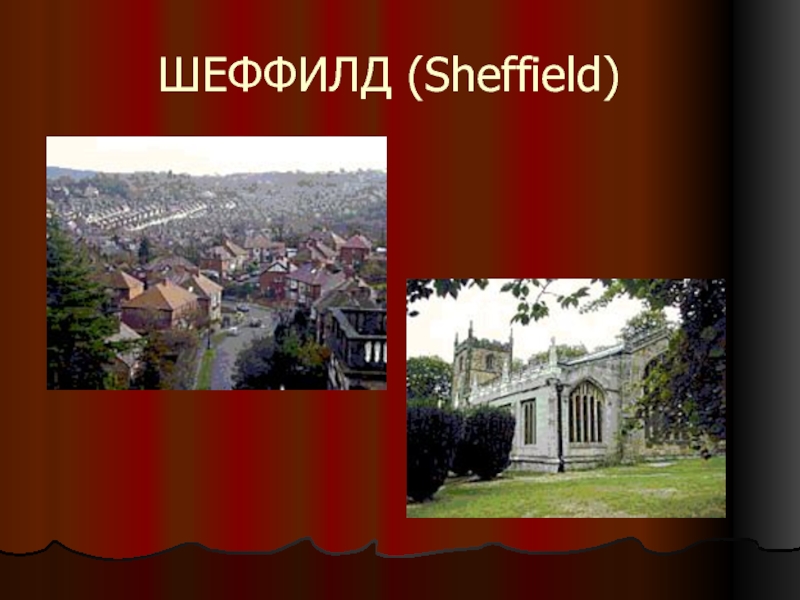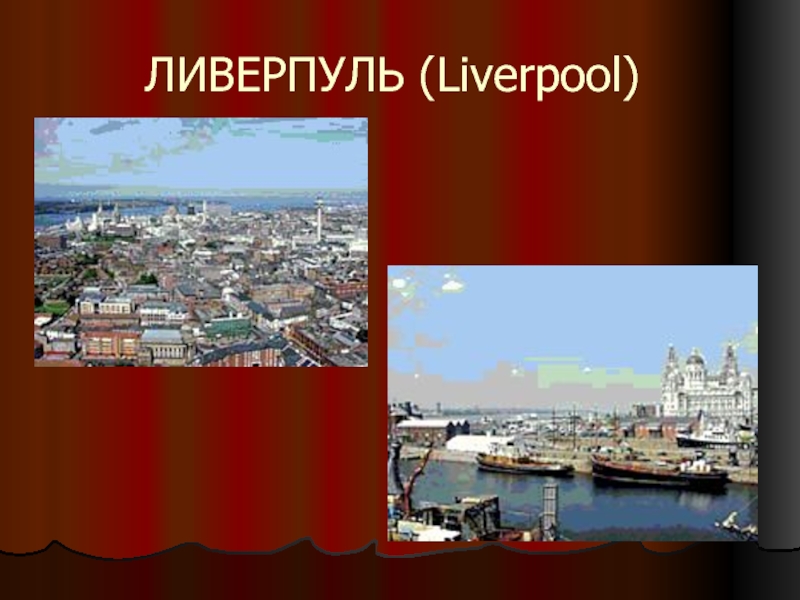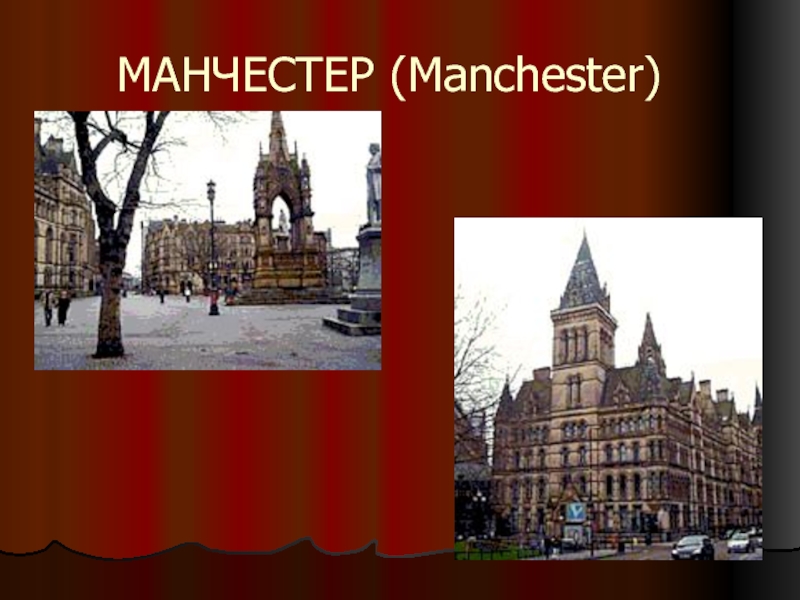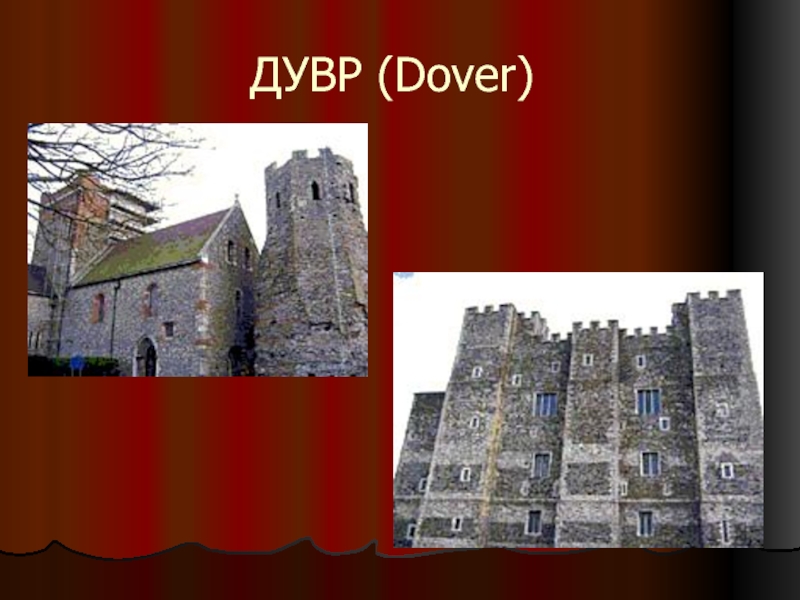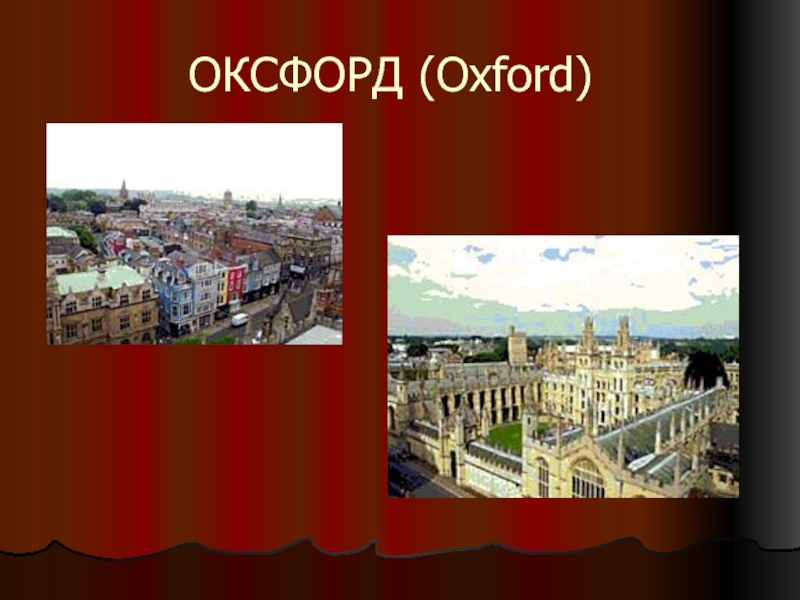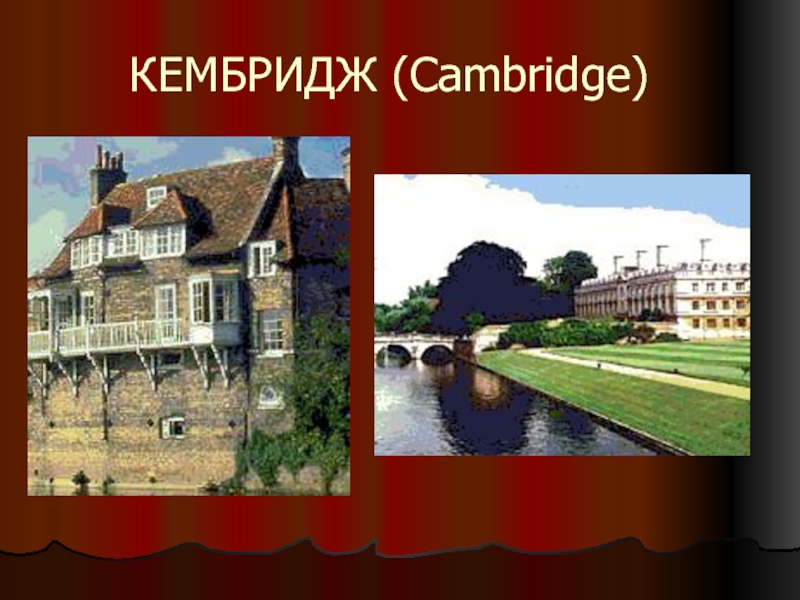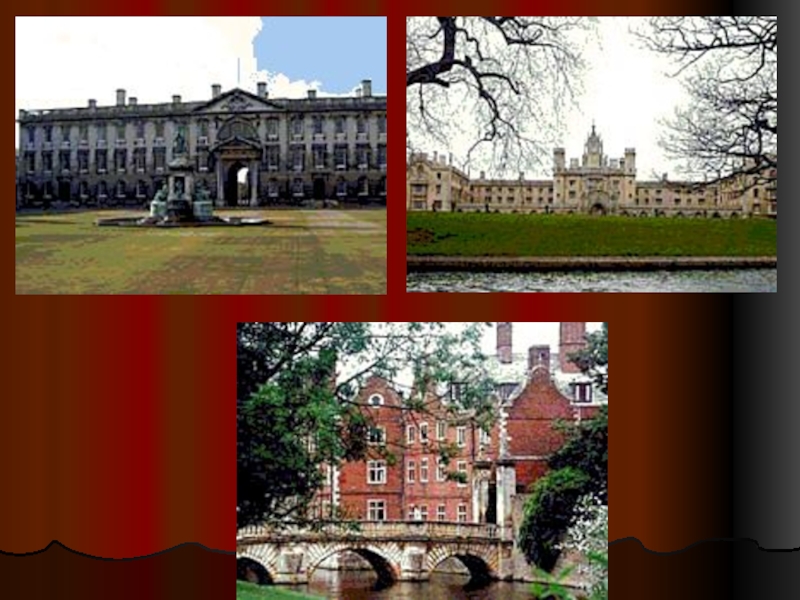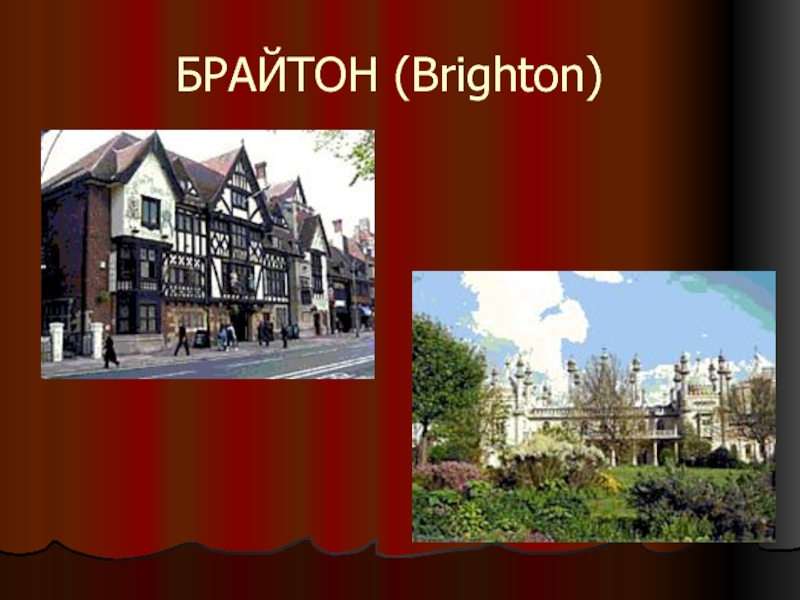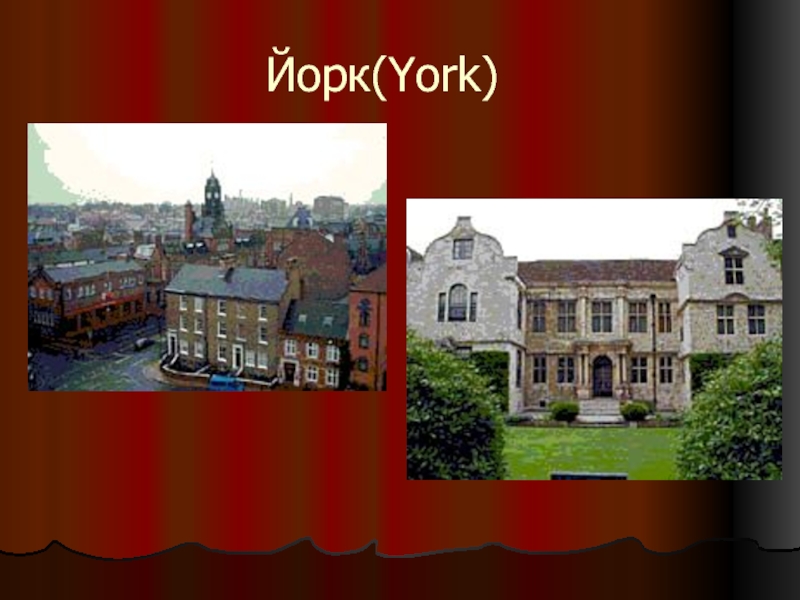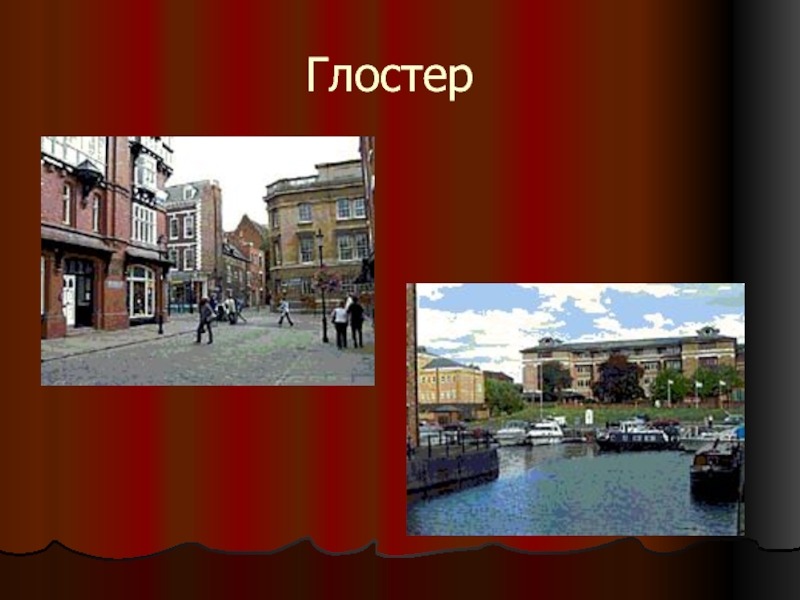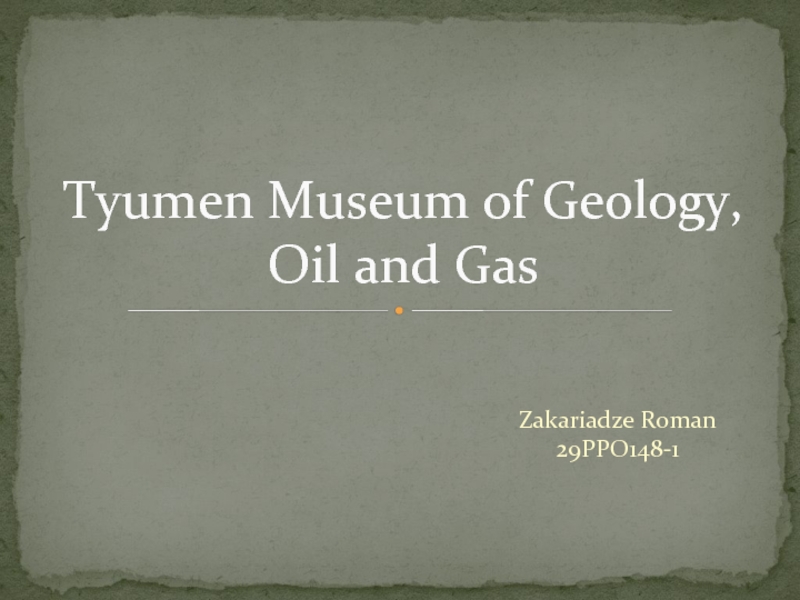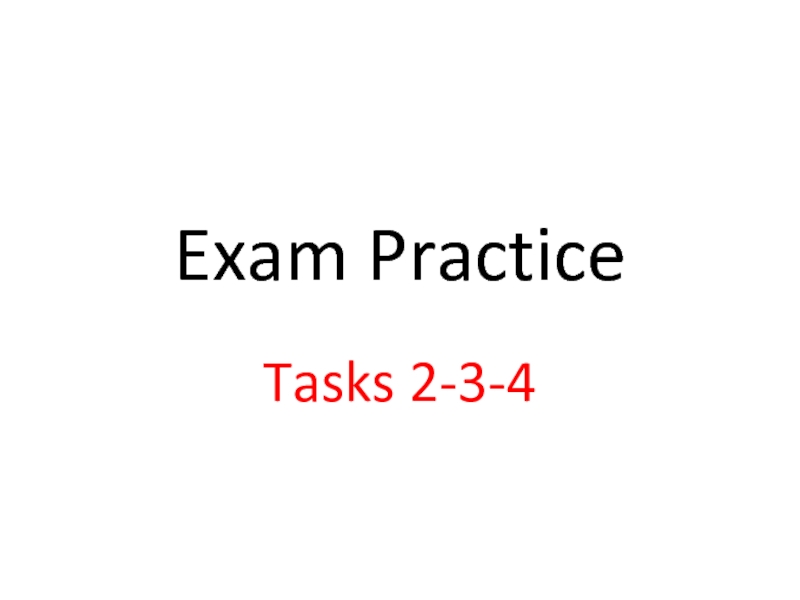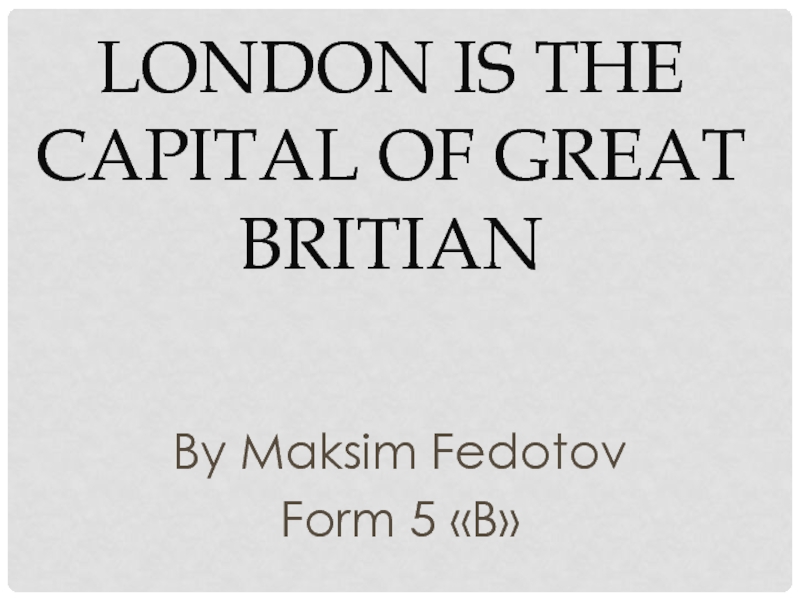England
Scotland
Wales
Northern Ireland
- Главная
- Разное
- Дизайн
- Бизнес и предпринимательство
- Аналитика
- Образование
- Развлечения
- Красота и здоровье
- Финансы
- Государство
- Путешествия
- Спорт
- Недвижимость
- Армия
- Графика
- Культурология
- Еда и кулинария
- Лингвистика
- Английский язык
- Астрономия
- Алгебра
- Биология
- География
- Детские презентации
- Информатика
- История
- Литература
- Маркетинг
- Математика
- Медицина
- Менеджмент
- Музыка
- МХК
- Немецкий язык
- ОБЖ
- Обществознание
- Окружающий мир
- Педагогика
- Русский язык
- Технология
- Физика
- Философия
- Химия
- Шаблоны, картинки для презентаций
- Экология
- Экономика
- Юриспруденция
The United Kingdom of Great Britain and Northern Ireland ( the UK ) презентация
Содержание
- 1. The United Kingdom of Great Britain and Northern Ireland ( the UK )
- 2. G r e a t B
- 3. The Union Jack This is the popular
- 4. British Royal Coat of Arms There are
- 5. The English Channel
- 6. Queens and Kings of the UK The
- 7. British Parliament Parliament consists of the Houses
- 8. England It is the largest and the
- 9. Scotland It takes one third of the
- 10. Wales The capital is Cardiff. The population
- 11. Northern Ireland Its capital is Belfast. It
- 12. London The capital of England and the
- 13. The Thames The Thames is not a
- 14. Edinburgh The capital of Scotland lies
- 15. Cardiff The capital of Wales was founded
- 16. Belfast Belfast, the capital of Northern
- 17. Stonehenge Near Sailsbury about 4.600 years ago
- 18. Sightseeing of London The Tower Piccadilly Circus
- 19. The Tower of London The Tower on
- 20. The Tower Bridge It was built at
- 21. London Bridge It is 2.000 years old.
- 22. The Houses of Parliament They were built
- 23. Big Ben It is a name
- 24. Westminster Abbey It is a fine Gothic
- 25. St. Paul’s Cathedral It is the work
- 26. Buckingham Palace Buckingham Palace is the
- 28. Trafalgar Square Trafalgar Square is in the
- 29. Piccadilly Circus It is conceded to be
- 30. Whitehall Whitehall is the street in London
- 31. Art Galleries There are very many Art
- 32. Parks of London Parks are
- 34. Royal London Many places in London are
- 35. The Tower of London The
- 36. Buckingham Palace Buckingham Palace has been
- 39. Windsor Castle Windsor Castle is the largest
- 41. St Jamese’s Palace
- 42. Westminster Abbey It is a
- 43. Parks All together there are 10 royal
- 46. Города Великобритании
- 47. БИРМИНГЕМ (Birmingham)
- 48. ЛИДС (Leeds)
- 49. ШЕФФИЛД (Sheffield)
- 50. ЛИВЕРПУЛЬ (Liverpool)
- 51. МАНЧЕСТЕР (Manchester)
- 52. ДУВР (Dover)
- 53. ОКСФОРД (Oxford)
- 54. КЕМБРИДЖ (Cambridge)
- 56. КОВЕНТРИ (Coventry)
- 57. БРАЙТОН (Brighton)
- 58. Йорк(York)
- 59. Глостер
Слайд 1The United Kingdom of Great Britain and Northern Ireland ( the
Слайд 2G r e a t B r i t a
composed by 5.500 islands
area - 244, 820 sq. km
population – 57 mln. People
Official language – English ( Scottish, Welsh, Irish – other languages )
Political system – constitutional monachy
Capital – London
The largest cities – London, Birmingham, Glasgow, Liverpool, Sheffield, Edinburgh, Bristol, Leeds
The largest ports – London, Liverpool, Belfast, Southampton, Glasgow, Cardiff
The chief rivers – the Severn, the Thames the Spey, the Tweed, the Clyde
The highest peeks – Ben Nevis ( 1343 m), Snowdon ( 1000 m )
Слайд 3The Union Jack
This is the popular name given to
the flag of
called the Union Flag and consists
of several flags.
It all began in 1603 when Scotland
was joined to England and Wales.
Later in 1801 the Irish Flag was
added.
In this way the British people got
the Union Flag, which is red, white
and blue. King James ( 1566-1625)
ordered the British Flag to be flown
on the main mast of all British ships,
it was flown on the bowsprit or the
Jack Star ( “jack” is the old word for
sailor).
Слайд 4British Royal Coat of Arms
There are two animals on it. One
is the lion. The “ king of beast” has been
used as a symbol of national strength and
of the British monarchy for many centuries.
The other one is the unicorn. The unicorn
is a mythical animal that looks like a horse
with a long straight horn growing from its
forehead, and is a symbol of purity.
Слайд 6Queens and Kings of the UK
The House of Normandy
William I1066 –
The House of Plantagenet
Henry II1154 – 1189 Richard I1189 – 1199 John1199 – 1216 Henry III1216 – 1272 Edward I1272 – 1307 Edward II1307 – 1327 Edward III1327 – 1377 Richard I1377 – 1399
The House of Lancaster
(Sub-division of Plantagenet)
Henry IV1399 – 1413 Henry V1413 – 1422 Henry VI1422 – 1461
The House of York
(Sub-division of Plantagenet)
Edward IV1461 - 1483 Edward V1483 - 1485
The House of Tudor
Henry VII1485 – 1509 Henry VIII1509 – 1547 Edward VI1547 – 1553 Mary I1553 – 1558 Elizabeth I1558 – 1603
The House of Stuart
James I1603 – 1625 Charles I1625 – 1649 The Commonwealth1649 – 1659 Charles II1660 – 1685 James II1685 – 1688 Mary II1689 -1694 William III1689 – 1702 Anna1702 - 1714
The House of Hanover
George I1714 – 1727 George II1727 – 1760 George III1760 – 1820 George IV1820 – 1830 William IV1830 – 1837 Victoria1837 – 1901
The House of Saxe – Coburg
Edward VII1901 – 1910
The House of Windsor
George V1901 – 1936 Edward VIII1936 George VI1936 – 1952 Elizabeth II1952 -
Слайд 7British Parliament
Parliament consists of the Houses of Lords ( 1200
Lords; Lord
Of Commons ( 650 MP; Speaker presides). There
Are 2 main parties: Conservative ( Tory) and
Liberal ( Whigs). The party which wins the most
Seats forms the Government and its leader becomes
a Prime Minister. The functions of Commons are
Legislation and security of government activities.
The government party sits on the Speaker’s right
And the members of Opposition –on the left. Now
The government party is Liberal, the Prime Minister
Is Anthony Blar.
Слайд 8England
It is the largest and the most industrial and densely populated
Its capital is London (7 mln people), other big cities are Birmingham, Manchester, Sheffield, Bristol, Liverpool and others.
The longest river is the Severn (388 km)
The most important is the Thames(354 km).
The main industries are iron and steel,
motor cars and railway engines, wool and cotton, heavy machinery and shipbuilding.
Слайд 9Scotland
It takes one third of the territory of the British Isles,
The highest point is in Scotland, it is Ben Nevis (1343 m). There are also many lakes, the best-known is Loch Ness where a large monster lives.
Until 1707 Scotland was an independent state and was forcefully joined into the UK.
The important industries are oil, iron, steel
Слайд 10Wales
The capital is Cardiff. The population is 3 mln. people and
Wales is a highland country, the highest mountain of the UK is Snowdon.
It has coal, gold, silver, lead and copper.
The most important industries are metal, steel, electronics, electric engineering and chemicals.
Слайд 11Northern Ireland
Its capital is Belfast. It is the smallest part of
For 7 centuries Ireland was a colony of Great Britain, in 1921 it became a British dominion, in 1949 only a small part was a part of the UK. But it has been struggling for their independence.
The main industries are linen and textiles, clothing, shipbuilding and engineering.
Слайд 12London
The capital of England and the UK was built by Romans
It consists of 3 parts: the City – a financial centre ( 2,6 sq. km), the West End – the historical and cultural centre and the East End – the district of workers.
There are a lot of places of interest, parks, palaces, churches, theatres and so on.
Слайд 13The Thames
The Thames is not a long river, it is 330
km
English people call it “ the Father of
London”. There are about 30 bridges
across the Thames ( the London Bridge,
the Tower Bridge and some others). There is a museum of old ships on the river. These ships are from the history of Great Britain.
One of them is the “ Discovery”, went
to the South Pole in 1901-1904.
Слайд 14Edinburgh
The capital of Scotland lies on seven hills and goes
Many great men have lived and worked there: R. Burns, W. Scott, R.L. Stevenson .
The main street – the Prince St. divides the city into “the old and new town”.
There are many places of interest: the Castle, the Holyrood Palace, the Scott monument, the Chapel of the Most Noble Order of the Thistle and others.
Слайд 15Cardiff
The capital of Wales was founded in 1147 as a Roman
There are also several theatres: the New Theatre is the home of the Welsh National Opera, etc.
University College has been a college of the federal University of Wales since 1893.
Слайд 16Belfast
Belfast, the capital of Northern
Ireland is the leading industrial
centre and
Its chief industries are the production of linen and other textiles, clothing, shipbuilding, engineering.
Слайд 17Stonehenge
Near Sailsbury about 4.600 years ago
the Stone inhabitants of Britain
Anenormous stone structure. The
largest of their stones weigh 50 tons,
the smallest - 5 tons. People used no
metal and their tools were made of
stone, bone and wood. They started
to build it in about 1.000 B.C. and
finished 600 years later. Thousands of
men and women took part in building
it.
Слайд 18Sightseeing of London
The Tower
Piccadilly Circus
St. Paul’s Cathedral
Westminster Abbey
Westminster Palace
( the
Buckingham Palace
Nelson’s Column
Слайд 19The Tower of London
The Tower on the north bank of the
is the most ancient building of London. It
was founded in the 11th century by William
the Conqueror. But each monarch left some
mark on it. For many centuries it has been a
fortress, a prison and a royal treasury. Now
it is a museum of arms and armour, it has
the Crown Jewels.
The White Tower was built by William the
Conqueror, it is the oldest tower.
The ravens live here as part of its history.
There is a legend that if the ravens fly away
the Tower and the UK will fall. That is why
the birds are carefully guarded.
Every night at 10 p.m. the Ceremony of the Keys
or locking up the Tower for the night takes place.
Слайд 20The Tower Bridge
It was built at the end of the 19th
century
style of the fortress. The bridge is
functioning perfectly well for such
a great city as modern London. It
can quickly swung open to let in
big ocean ships that can move up
the Thames from the ocean.
The territory between the Tower
and London bridges is called the
Pool for this reason. So that people
could walk along the bridge at the
time its lower part is open, a pass
is made in its upper part. Almost
nobody uses this part of the bridge
nowadays though.
Слайд 21London Bridge
It is 2.000 years old. The 1st bridge
Was built of
There were houses and shops on it
and people paid money crossing it.
In 1831 a new bridge rose on that
place. In 1960 Londoners built new
bridge again.
A very rich American bought the old
London Bridge and brought it to
Arizona. There is no river under it
now but a street.
In 1973 the new London Bridge was
open over the Thames.
Слайд 22The Houses of Parliament
They were built in 1840-1852, but
The Westminster
1097-1099 and was a part of old
Palace. The Palace has 2 miles of
corridors and more than 1.100
rooms. When Parliament is sitting
a flag flies from the Victoria Tower
( the tallest tower of the complex)
and the light shines by night.
Visitors can watch the House of
Commons and the House of Lords
at work from the Stranger’s Gallery
This building contains the universal
Symbol of London and the UK, Big Ben.
Слайд 23Big Ben
It is a name of the 13,5-ton bell. It is
the Clock Tower of the Houses of Parlia-
ment. The great bell got its name in the
19th century after Sir Benjamin Hall, the
first Commissioner of Works. He was
very tall and the workers called him Big
Ben, so they called the clock and the
Tower Big Ben. People can hear the
sound of the bell every hour. On New
Year’s night people come to the Clock
Tower to see the New Year in.
Слайд 24Westminster Abbey
It is a fine Gothic building, it is the work
of many hands and different ages. The
oldest part dates the 8th century, it was a
monastery-the West Minster. In the 11th
century Edward the Confessor founded a
Norman Abbey. It is the highest church in
London ( 103 feet). The towers were built
in 1735-1740.The Abbey is famous for its
collection of swords and stained glass.
It is the crowning place of the kings and
queens of the UK, there is the Stone of
Destiny.
Many kings and queens are buried here with
famous scientists, writers and poets, there is
Famous Poets’ Corner where are many memo-
rials for outstanding people.
Слайд 25St. Paul’s Cathedral
It is the work of the famous Sir Ch.
The work began in 1675, it lasted for 35
years. It has the huge dome with a gold
ball and cross on the top. Inside it is full
of Monuments. You can climb 263 steps
To The Whispering Gallery, to reach foot
Of the ball you must climb 637 steps.
In the Cathedral there are graves of Sir
Christopher Wren, admiral Nelson, the
Duke of Wellington, painter Sir Joshua
Reynolds.
Слайд 26Buckingham Palace
Buckingham Palace is the London home of the sovereign.
Buckingham Palace has been the London residence of British monarchs since 1830. When the monarch is in residence ( living in the Palace) the Royal standart is flown from the flagstaff, high above the famous balcony on which members of the royal family appear on special occasions. During the periods of residence, the ceremony of changing the guards takes place in the Palace courtyard. Although the front of the Palace is near the road, at the back the large gardens, with a lake and many fine trees, from a lovely setting for the garden parties and open-air receptions given by the Queen during the summer months.
Слайд 28Trafalgar Square
Trafalgar Square is in the centre
of the West End
the north side is the National
Gallery; in the north-east corner
is the National Portrait Gallery,
and in the centre is Nelson’s
Column with the figure of the
great seaman. It was erected in
1840s to celebrate his victory at
The Battle of Trafalgar in 1805.
Слайд 29Piccadilly Circus
It is conceded to be the real centre
of London.
because of its round form. It is
also the heart of London’s world.
Within a few hundred yards of it
there are most of London’s theatres
cinemas and restaurants. At night it
is a colourful sight. Also it is the
favorite place for walking. There is
a large underground station where
several different lines meet.
Слайд 30Whitehall
Whitehall is the street in London where many of the British
Offices stand. It runs from Trafalgar Square to Parliament Square. The
British government itself is often called Whitehall because there are many
Government offices in this street. Here we can see the Home Office, the
Treasury, the War Office, the Admiralty and other government departments,
Each housed in its own building.
This street is called so because at one time a big white palace, or hall, stood
In this street, where kings and their families lived. Only the old Banqueting
House remains today. It is one of London’s beautiful buildings. It stands
Opposite the Horse Guards.
Opposite the Home Office and in the middle of the street is the Cenotaph,
A monument to fallen in two world wars. It was built in 1920 after World
War I. every day people put flowers at the foot of the Cenotaph.
Слайд 31Art Galleries
There are very many Art Galleries in London.
The National Gallery
19th centuries.
The Tate Gallery ( 1897) houses the more modern British painters. It exhibits a number of
interesting collection of British and foreign modern painting and also modern sculpture.
The British Museum is the best-known national museum of antiquities of Egypt and Greece
and ethnography. Its library has more than 6 mln.books that occupy more than 80 miles of
shelves.
The Old Curiosity Shop is also a museum and still not quite a museum. It was described in
Ch. Dickens's novel and many tourists come to see it as part of Dickens’s London. But it still
a shop selling antiquities.
Madam Tussaud’s Museum is an exhibition of hundreds of life-size wax modals of famous
people of yesterday and today. The collection was started by Madam Tussaud, a French
modelers in wax, in the 18th century. Here you can meet Marilyn Monroe, Elton John,
Picasso, the Royal Family, the Beatles and many others: writers, movie stars, singers,
politicians, sportsmen, etc
Слайд 32Parks of London
Parks are the main attraction of
London. They occupy the
part of the city. There are many
lawns in the parks where people
lie or sit about.
Hyde Park with Speaker’s Corner
St. James's Park with the Zoo
Regent’s Park
Слайд 34Royal London
Many places in London are closely connected with the Crown.
Слайд 35The Tower of London
The Tower on the north bank of the
is the most ancient building of London. It
was founded in the 11th century by William
the Conqueror. But each monarch left some
mark on it. For many centuries it has been a
fortress, a prison and a royal treasury. Now
it is a museum of arms and armour, it has
the Crown Jewels.
The White Tower was built by William the
Conqueror, it is the oldest tower.
Слайд 36Buckingham Palace
Buckingham Palace has been the London residence of British
Слайд 39Windsor Castle
Windsor Castle is the largest castle in Britain. Set on
The castle was first a simple structure used as a hunting lodge. Then it became a well-appointed royal residence. Since then, it has been a favorite home for royal family, made all the more so by a disastrous fire in 1992. Restoration, funded partly by opening Buckingham Palace to the public, was carried out to the highest standard and the castle is once again a favorite place with royalty and tourists alike.
Слайд 42Westminster Abbey
It is a fine Gothic building, it is the work
of many hands and different ages. The
oldest part dates the 8th century, it was a
Monastery - the West Minster..
It is the crowning place of the kings and
queens of the UK, there is the Stone of
Destiny.
Many kings and queens are buried here.

